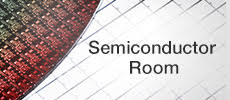
5. Integrated circuit (IC)
An integrated circuit (ICs) is an electronic device comprising numerous functional elements such as transistors, resistors, condensers, etc. on a piece of silicon semiconductor substrate, and is sealed inside a package with multiple terminals. At present, IC critical dimensions (or smallest dimensions of IC elements) are in the order of 10 nanometers (nm: 10-9m), which is extremely small.
Transistor radios that fascinated boys in the old days consisted of a piece of printed board with discrete transistors, resistors, condensers and diodes inserted, which were wired to each other. The current IC is highly integrated and miniaturized, about 1/55000 of the size and 3 billionths of the area of the transistor radio. Owing to their high integration, ICs with various functions embedded have dramatically enhanced the performance of electronics.
In the manufacturing of ICs, many ICs are made on a silicon wafer and then cut (diced) into numerous IC chips (dies). The IC chips are sealed inside packages because they are too small to be electrically bonded to a printed circuit board, and also because IC chips would get broken if left unprotected.
If you open the cover of a personal computer, you will see objects with multiple legs sticking out. These are the ICs hidden inside the packages.
Depending on the number of components, ICs are classified as LSI (large-scale integration), VLSI(very large scale integration), and ULSI(ultra large scale integration). Normally the “VLSI” term covers "ULSI".



